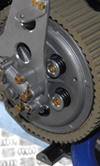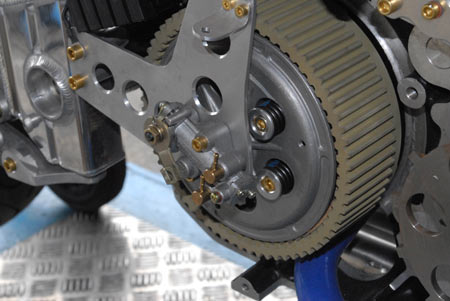A balancing act
 I wish I had a fiver (about $8) for every time a racing driver mentioned the word 'balance.' The post-practice or post-race interview of explanations and excuses as to why he (or she) didn't win invariably attributes the cause to the relative grip between front and rear tyres, thus allowing the car to oversteer (loose) or understeer (push). And away from optimum handling, how could he (or she) possibly ever be expected to win? But in the world of engine lubricants the word 'balance' assumes an altogether different level of significance, albeit of equal importance.
I wish I had a fiver (about $8) for every time a racing driver mentioned the word 'balance.' The post-practice or post-race interview of explanations and excuses as to why he (or she) didn't win invariably attributes the cause to the relative grip between front and rear tyres, thus allowing the car to oversteer (loose) or understeer (push). And away from optimum handling, how could he (or she) possibly ever be expected to win? But in the world of engine lubricants the word 'balance' assumes an altogether different level of significance, albeit of equal importance.
The modern internal combustion engine is a complex mechanical device, and none more than that used in motorcycle racing. The valvetrain, piston ring and bearings all have their own individual lubrication requirements which, along with others (for example, the ability to keep the engine clean), makes the task of producing an oil with the optimum 'balance' of properties for any particular engine quite tricky.
The oil intended for the MotoGP Honda, for example, will be different from that of the Ducati. This is down to the differences in relative motion of the parts inside the engine and the type of lubrication experienced between them, as well the different temperatures involved. However, motorcycles have other requirements not normally found in other vehicles. You see, they tend to use the same oil in the gearbox as that in the engine, and if the design also includes what is best described as a 'wet' clutch, the oil will have to cope with that as well.
Gearbox oils, while fundamentally similar to engine oils in many ways, need one characteristic not normally found in a combustion engine - the ability to cope with the high contact loads between meshing teeth. In a traditional spur gear system, as the teeth move in and out of engagement the relative motion of the surfaces produces a mixture of high-friction boundary lubrication, mixed and full-film lubrication depending on the speed of the shafts. Narrow gears and high contact tooth pressures, depending on the design of the gear sets, may therefore need certain extreme-pressure or EP additives to prevent the adjacent metal surfaces from coming into contact, which would otherwise cause fatigue damage and subsequent pitting of the teeth.

The most effective anti-wear and extreme-pressure additives still tend to be ZDDPs (zinc dialkyldithiophosphates) although other borate-based ones may also be commonly used. Extreme pressure additives are said to be 'surface active', and attach themselves by polar attraction to the surface of the metal in a similar way to the detergents (and other additives), which are also polar. Since competition oils are frequently changed, they don't generally require the same level of cleanliness as for, say, road bikes and therefore the removal of the detergent can sometimes act as a bonus, enhancing the anti-wear properties in the oil. But depending on the basestock and the additives used, the oil may need to be 're-balanced' to avoid one additive dominating.
The other complication in a motorcycle can be that of the wet clutch. More common in production motorcycles - where, for reasons of reliability, heat generated in the clutch pack needs to be cooled by the oil supply - yet another demand is placed on the lubricant. Passenger car engine oils (PCMOs) these days tend to incorporate certain friction modifiers to reduce boundary-layer friction at the top ring reversal point and at various points on the camshaft. Used within the confines of a clutch system, these additives may interfere with the operation of the clutch, which will struggle to maintain the level of grip required between the plates and rings, leading to clutch slippage. Likewise, with too high a level of friction, the operation of the clutch could be too viscous, making the bike very difficult to ride in confined places by the inexperienced rider. Removing the friction modifier will have implications to the engine lubrication, and so once more the oil may have to be 're-balanced' to suit.
But how many racers will blame the balance of the oil if they don't win?
Fig. 1 - A dry clutch cooled by air rather than oil
Written by John Coxon